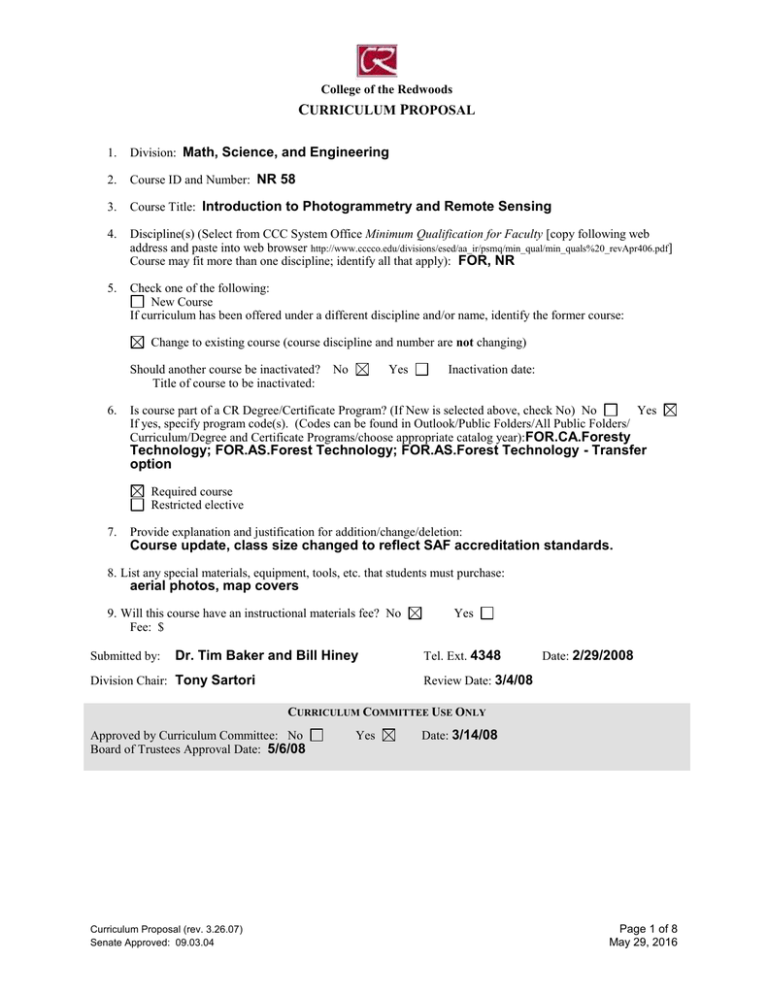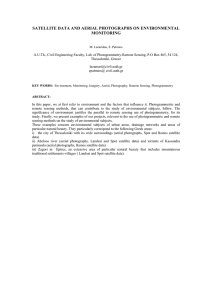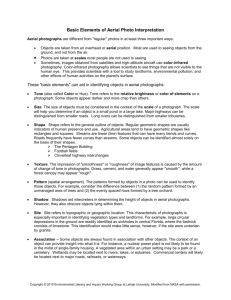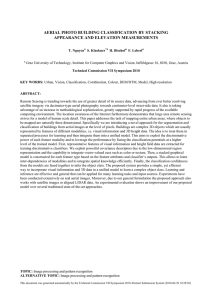C P URRICULUM
advertisement

College of the Redwoods CURRICULUM PROPOSAL 1. Division: Math, Science, and Engineering 2. Course ID and Number: NR 58 3. Course Title: Introduction to Photogrammetry and Remote Sensing 4. Discipline(s) (Select from CCC System Office Minimum Qualification for Faculty [copy following web address and paste into web browser http://www.cccco.edu/divisions/esed/aa_ir/psmq/min_qual/min_quals%20_revApr406.pdf] Course may fit more than one discipline; identify all that apply): FOR, NR 5. Check one of the following: New Course If curriculum has been offered under a different discipline and/or name, identify the former course: Change to existing course (course discipline and number are not changing) Should another course be inactivated? Title of course to be inactivated: 6. No Yes Inactivation date: Is course part of a CR Degree/Certificate Program? (If New is selected above, check No) No Yes If yes, specify program code(s). (Codes can be found in Outlook/Public Folders/All Public Folders/ Curriculum/Degree and Certificate Programs/choose appropriate catalog year):FOR.CA.Foresty Technology; FOR.AS.Forest Technology; FOR.AS.Forest Technology - Transfer option Required course Restricted elective 7. Provide explanation and justification for addition/change/deletion: Course update, class size changed to reflect SAF accreditation standards. 8. List any special materials, equipment, tools, etc. that students must purchase: aerial photos, map covers 9. Will this course have an instructional materials fee? No Fee: $ Submitted by: Dr. Tim Baker and Bill Hiney Division Chair: Tony Sartori Yes Tel. Ext. 4348 Date: 2/29/2008 Review Date: 3/4/08 CURRICULUM COMMITTEE USE ONLY Approved by Curriculum Committee: No Board of Trustees Approval Date: 5/6/08 Curriculum Proposal (rev. 3.26.07) Senate Approved: 09.03.04 Yes Date: 3/14/08 Page 1 of 8 May 29, 2016 SUMMARY OF CURRICULUM CHANGES FOR AN EXISTING COURSE FEATURES OLD NEW Measurement of land areas, boundaries, elevations, and tree heights from aerial photographs. Includes the practices and principles of interpreting aerial photographs, with emphasis on forest typing, mapping, and inventory. Remote Sensing principles and images will be introduced with an emphasis on interpretation and classification. An introduction to the interpretation and use of aerial photographs, electronically generated imagery, and remotesensing data. Students will learn the theory and practice of gathering and examining remotesensing data, the classification of land areas, and the measurement of ground-based objects from aerial photographs. Select Select Recommended Preparation FOR 1, Algebra course ENGL 350, MATH 106 Maximum Class Size 30 25 Catalog Description (Please include complete text of old and new catalog descriptions.) Grading Standard Total Units Lecture Units Lab Units Prerequisites Corequisites Repeatability— Maximum Enrollments Other update to course learning outcomes, concepts and skills If any of the listed features have been modified in the new proposal, indicate the “old” (current) information and proposed changes. Curriculum Proposal (rev. 3.26.07) Senate Approved: 09.03.04 Page 2 of 8 May 29, 2016 College of the Redwoods COURSE OUTLINE DATE: 2/29/2008 COURSE ID AND NUMBER: NR 58 COURSE TITLE: Introduction to Photogrammetry and Remote Sensing FIRST TERM NEW OR REVISED COURSE MAY BE OFFERED: Fall 2008 TOTAL UNITS: 2 TOTAL HOURS: 72 [Lecture Units: 1 [Lecture Hours: 18 Lab Units: 1] Lab Hours: 54] MAXIMUM CLASS SIZE: 25 GRADING STANDARD Letter Grade Only CR/NC Only Is this course repeatable for additional credit units: No Grade-CR/NC Option Yes If yes, how many total enrollments? Is this course to be offered as part of the Honors Program? No Yes If yes, explain how honors sections of the course are different from standard sections. CATALOG DESCRIPTION The catalog description should clearly state the scope of the course, its level, and what kinds of student goals the course is designed to fulfill. An introduction to the interpretation and use of aerial photographs, electronically generated imagery, and remote-sensing data. Students will learn the theory and practice of gathering and examining remote-sensing data, the classification of land areas, and the measurement of ground-based objects from aerial photographs. Special notes or advisories: Field trips are required; the College does not provide transportation. PREREQUISITES No Yes Course(s): Rationale for Prerequisite: Describe representative skills without which the student would be highly unlikely to succeed . COREQUISITES No Yes Rationale for Corequisite: Course(s): RECOMMENDED PREPARATION Curriculum Proposal (rev. 3.26.07) Senate Approved: 09.03.04 Page 3 of 8 May 29, 2016 No Yes Course(s): ENGL 350; MATH 106 Rationale for Recommended Preparation: Students will have difficulty with the reading and with the mathematics associated with measurements from aerial photos without adequate preparation. COURSE LEARNING OUTCOMES What should the student be able to do as a result of taking this course? State some of the objectives in terms of specific, measurable student accomplishments. 1. Use stereoscopy to determine heights, elevations and topography of ground-based structures. 2. Develop cover-type maps based on interpretation of aerial photographs. 3. Calculate flight elevations, paths, exposures and other photographic techniques. 4. Calculate scales, distances and ground areas from aerial photos and remote-sensing data. 5. Describe appropriate use of different wavelengths from remote-sensing data to determine cover and forest health. COURSE CONTENT Themes: What themes, if any, are threaded throughout the learning experiences in this course? Concepts: What concepts do students need to understand to demonstrate course outcomes? 1. Parallax and stereoscopy. 2. Wavelengths and filters in gathering remote-sensing data. 3. Flight paths and photographic techniques. 4. Relationship of remote-sensing data to ground and foliage conditions. 5. Scales and topographic features from 3-dimensional views in aerial photographs. Issues: What primary issues or problems, if any, must students understand to achieve course outcomes (including such issues as gender, diversity, multi-culturalism, and class)? Skills: What skills must students master to demonstrate course outcomes? 1. Stereoscopy of aerial photographs. 2. Obtaining measurements from aerial photographs. 3. Developing cover-type maps from aerial photographs. 4. Determining forest health from false-infrared wavelengths in remotely-sensed data. REPRESENTATIVE LEARNING ACTIVITIES What will students be doing (e.g., listening to lectures, participating in discussions and/or group activities, attending a field trip)? Relate the activities directly to the Course Learning Outcomes. 1. Listening to lectures on the theory and principles of photogrammetry and remote sensing. 2. Participating in discussions on the use of aerial photos and remote-sensing in land management. 3. Conducting laboratory exercises in gathering measurements and interpreting aerial photographs. ASSESSMENT TASKS How will students show evidence of achieving the Course Learning Outcomes? Indicate which assessments (if any) are required for all sections. Curriculum Proposal (rev. 3.26.07) Senate Approved: 09.03.04 Page 4 of 8 May 29, 2016 Representative assessment tasks: 1. Quizzes. 2. Practical exams. 3. Mapping projects. Required assessments for all sections – to include but not limited to: 1. Comprehensive final exam. EXAMPLES OF APPROPRIATE TEXTS OR OTHER READINGS Author, Title, and Date Fields are required Author Paul R. Wolf Author Robert Title Elements of Photogrammetry with Applications in GIS H. Arnold Title Date 2000 Interpretation of Airphotos and Remotely Sensed Imagery Date 2004 Author Avery & Berlin Title Fundamentals of Remote Sensing and Airphoto Interpretation Date 1992 Author David Date P. Paine and James D. Kiser Title Aerial Photography and Image Interpretation 2003 Other Appropriate Readings: Curriculum Proposal (rev. 3.26.07) Senate Approved: 09.03.04 Page 5 of 8 May 29, 2016 PROPOSED TRANSFERABILITY: CSU UC If CSU transferability is proposed (courses numbered 1-99), indicate whether general elective credit or specific course equivalent credit is proposed. If specific course equivalent credit is proposed, give course numbers/ titles of at least two comparable lower division courses from a UC, CSU, or equivalent institution. None General elective credit Specific course equivalent 1. FOR 216, HSU 2. , (Campus) (Campus) CURRENTLY APPROVED GENERAL EDUCATION CR CSU IGETC CR GE Category: CSU GE Category: IGETC Category: PROPOSED CR GENERAL EDUCATION Rationale for CR General Education approval (including category designation): Natural Science Social Science Humanities Language and Rationality Writing Oral Communications Analytical Thinking PROPOSED CSU GENERAL EDUCATION BREADTH (CSU GE) A. Communications and Critical Thinking A1 – Oral Communication A2 – Written Communication A3 – Critical Thinking C. Arts, Literature, Philosophy, and Foreign Language C1 – Arts (Art, Dance, Music, Theater) C2 – Humanities (Literature, Philosophy, Foreign Language) E. Lifelong Understanding and SelfDevelopment E1 – Lifelong Understanding E2 – Self-Development B. Science and Math B1 – Physical Science B2 – Life Science B3 – Laboratory Activity B4 – Mathematics/Quantitative Reasoning D. Social, Political, and Economic Institutions D0 – Sociology and Criminology D1 – Anthropology and Archeology D2 – Economics D3 – Ethnic Studies D5 – Geography D6 – History D7 – Interdisciplinary Social or Behavioral Science D8 – Political Science, Government and Legal Institutions D9 – Psychology Rationale for inclusion in this General Education category: Same as above Curriculum Proposal (rev. 3.26.07) Senate Approved: 09.03.04 Page 6 of 8 May 29, 2016 Proposed Intersegmental General Education Transfer Curriculum (IGETC) 1A – English Composition 1B – Critical Thinking-English Composition 1C – Oral Communication (CSU requirement only) 2A – Math 3A – Arts 3B – Humanities 4A – Anthropology and Archaeology 4B – Economics 4E – Geography 4F – History 4G – Interdisciplinary, Social & Behavioral Sciences 4H – Political Science, Government & Legal Institutions 4I – Psychology 4J – Sociology & Criminology 5A – Physical Science 5B – Biological Science 6A – Languages Other Than English Rationale for inclusion in this General Education category: Curriculum Proposal (rev. 3.26.07) Senate Approved: 09.03.04 Same as above Page 7 of 8 May 29, 2016 FOR VPAA USE ONLY PROGRAM AND COURSE NUMBER NR-58 TECHNICAL INFORMATION 1. Department: SCI Science 16. CoRequisite Course: None 2. Subject: NR 17. Recommended Prep: ENGL-350 and MATH 106 Course No: 58 3. Credit Type: D Credit Degree Applicable 18. Maximum Class Size: 25 4. Min/Maximum Units: 2.0 to 19. Repeat/Retake: NR No repeats variable units 5. Course Level: C Clearly Occupational 20. Count Retakes for Credit: yes no 6. Academic Level: UG Undergraduate 21. Only Pass/No Pass: yes no 7. Grade Scheme: UG Undergraduate 22. Allow Pass/No Pass: yes no 8. Short Title: Intro Photo & Remote Sensing 23. VATEA Funded Course: yes no 9. Long Title: Introduction to Photogrammetry 24. Accounting Method: W Weekly Census and Remote Sensing 25. Disability Status: N Not a Special Class 10. National ID (CIP): 03.0101 26. Billing Method: T-Term 11. Local ID (TOPS): 011500 27. Billing Period: R-Reporting Term 12. Course Types: Level One Basic Skills: NBS Not Basic Skills Level Two Work Experience: 28. Billing Credits: 2.0 29. Purpose: I Occupational Ed NWE Not Coop Work Experience 30. Articulation No. Level Three: (CAN): Placeholder for GE OR 31. Articulation Seq. (CAN): DOES NOT APPLY 32. Transfer Status: B Transfers to CSU only Level Four: If GE : Choose One: 33. Equates to another course? (course number). 13. Instructional Method: LL Lecture/Lab 14. Lec TLUs: 1.5 Contact Hours: 18 Lab TLUs: 3.0 Contact Hours: 54 Lecture/Lab TLUs: Contact Hours: 34. The addition of this course will inactive number). Inactive at end of term. 15. Prerequisite: None Particular Comments for Printed Catalog. . Curriculum Approval Date: 3/14/08 Curriculum Proposal (rev. 3.26.07) Senate Approved: 09.03.04 Page 8 of 8 May 29, 2016 (course




